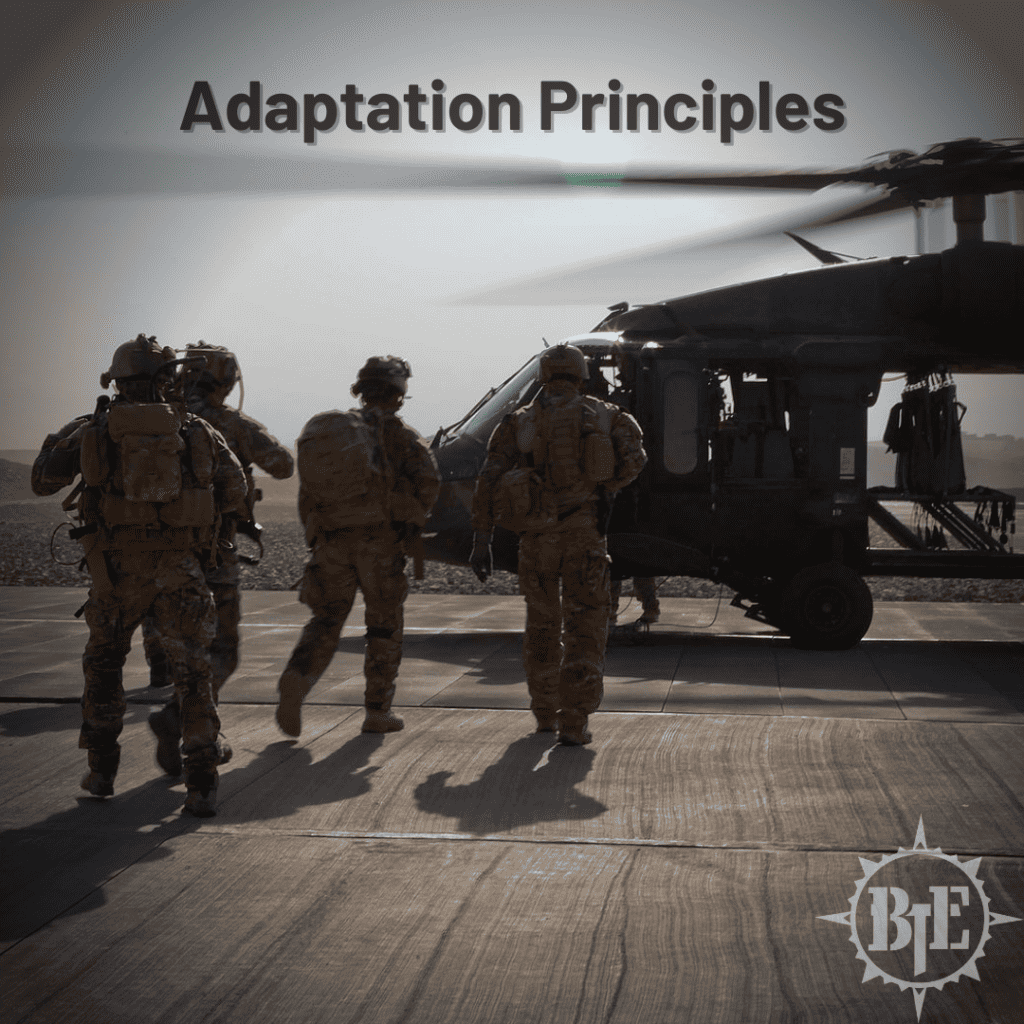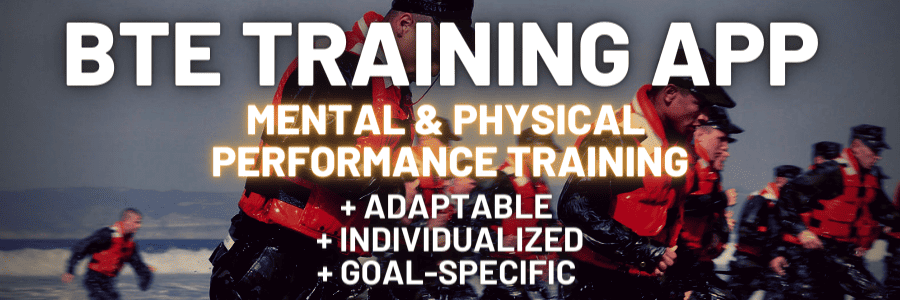In order to understand programming, you first have to know how and why your body responds to training. When you internalize that framework, things like how much running to do, how fast, and how often become much easier to program and adjust.
Just like programming, adaptation is a complex subject that people spend their entire careers studying. We are going to discuss the principles that you need when coaching yourself or others and will not be going into the weeds.
Allostasis*
Your body is always adapting. Everything that you do places a stressor on the body and it responds accordingly to keep you alive. This ever-changing process is called allostasis. Technically speaking, allostasis is the total physiological reaction of your body to the stressors that you place upon it in order to maintain function.
Your body has two main responses to any stress: a short-term response and a long-term response. The short-term response is simple – get through the moment. This is usually characterized by flooding the body with hormones and redistributing blood flow and energy to the appropriate system and local area within the body.
Once the stressor has been dealt with, the long-term adaptation component kicks in – prepare for the future moment. Your body releases enzymes or signaling hormones that start a cascade of responses which create a more permanent adaptation. The outcome of this is your body being able to deal with the stressor in the future. The magnitude of the signaling response is directly proportional to the load of the stressor. This is why the body stops adapting when the same stressor is imposed repeatedly (such as doing the same workout plan every week).
*Allostasis, homeostasis, periodization, and general adaptation syndrome are all complex topics worth spending some time reading on. However, in the name of simplicity and effectiveness, the terminology is simplified here in a way that isn’t technically rigorous for the sake of usability.
Too much of a good thing
While these adaptations can lead to the improvements we are looking for, the problem is that most of us spend way too much time accumulating stress and not enough time recovering. So, our allostatic load (i.e. the total load of all stressors in life) is constantly elevated. This leads to a high cost of adaptation to exercise.
People generally tend to fall into one of two camps described below.
Net Positive Adaptation Process: the body has a surplus of resources created by balancing recovery and training stressors, so the body utilizes these resources to create an adaptation to the training you’re doing (gain muscle, more mitochondria, new or stronger neural connections in the brain, etc).
Net Negative Adaptation Process: the body adapts to your training stimulus, but by doing so you become vulnerable to other problems because of the cumulative and progressive nature of stress. Do this for long enough and you can get injured, burned out, sick, hormonally imbalanced, etc.
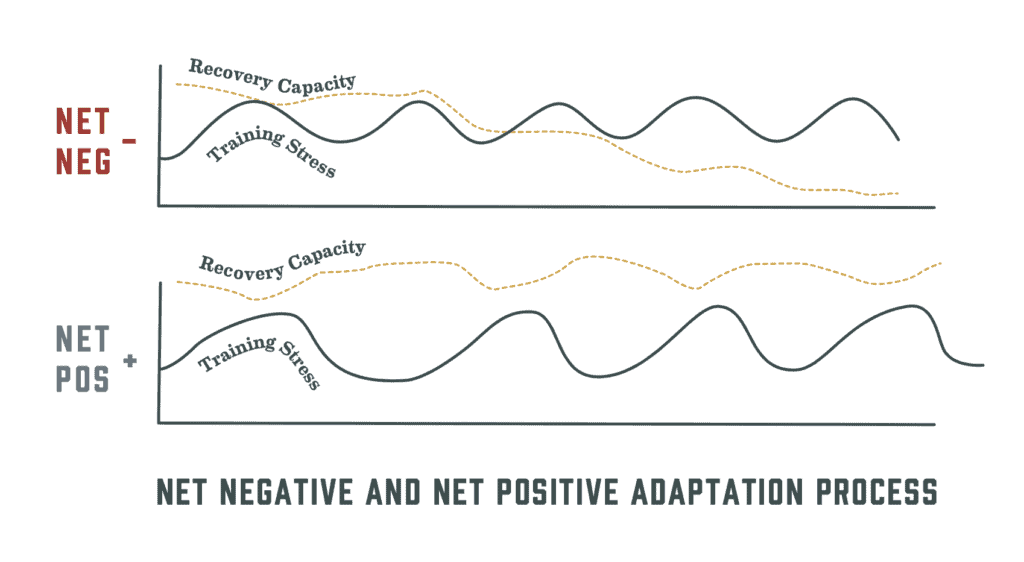
In other words: if you train hard, your body will adapt, but the cost of adaptation varies. Both processes are utilizing resources to create an adaptation, but one comes at the expense of health, while the other maintains it and improves resilience.
Before we talk about how to create a net positive adaptation process, we need to explore some of the nuances of adaptation.
Everything is a stressor
Stress is anything that elicits a response from the body. Food, light, sound, movement, exercise, emotional events, and mental strain are all stressors. Anything that has an effect on your body must be considered when planning and executing a training program because it will change your response to training. This is especially important when considering writing a program for an individual whose entire life doesn’t revolve around training. Outside stressors such as relationships, work, and sleep / recovery constraints will play a large role in how the trainee adapts.
Your body is always adapting
Adaptations are almost always useful from the perspective of your body. For example, if you bury yourself under an extreme load of endurance work, your body may ramp up cortisol, slow down sex hormone production, and a bunch of other ‘negative’ effects, but it’s doing so to protect itself. This adaption is serving the purpose, really, of trying to stop you from being stupid. It’s only negative from your perspective, but from the body’s perspective, it’s doing what it needs to do to survive, and to get you to stop doing so much because it can’t cope effectively. The magnitude of the signaling response is directly proportional to the load of the stressor. In other words, the total load controls the intensity of the stress response.
There’s a sweet spot in this process – creating a stimulus that leads to the adaptations we want, without leading to the ‘negative’ adaptations we don’t want.
Two Types of Stress
There are two main types of stress:
Specific Stress: the specific signaling and adaptive response that occurs based on the type of stress that is applied to the body (think strength workout vs aerobic conditioning workout).
General Stress: the cumulative stress load or the total amount of stress applied to the body from all stressors is referred to as general stress.
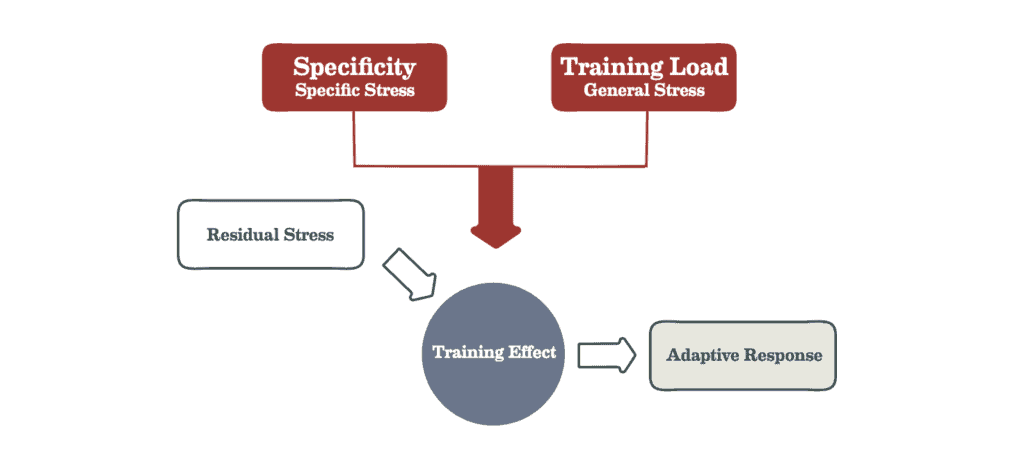
Training disrupts homeostasis, which creates a signaling response to the various systems within the body that cause specific chain reactions depending on a variety of factors, including:
- Genetics
- Fitness Level
- Training Load
- Training History
The degree of the hormonal response, and your body’s sensitivity to that response, depends on a variety of factors including genetics, receptor sensitivity, and where your body is in the stress response.
Residual stress
Residual stress is any pre-existing accumulated stress from a previous training session. If incomplete recovery occurs between sessions, residual stress becomes a part of the equation.
A good example of residual specific stress is muscle damage. Your central nervous system might be fully recovered but the local muscle might still be recovering. Think squats for volume on Monday followed by squats for volume on Wednesday – you probably feel just fine, but your quads are smoked. In this situation, your brain can signal the muscle to contract as intensely as it had in the previous training session, but the local musculature might not be able to deal with the stressor and could lead to injury.
Of course, residual general stress also affects your body – one example would be running ten miles on Monday, and swimming laps to exhaustion on Wednesday – different local stressors, but large endurance load. If your cardiovascular system was insufficiently recovered from the previous day’s training session and you decide to perform a cardiac intensive workout, not only will your workout performance likely be poor, but your stress response will be amplified, increasing the cost of adaptation and pushing out the recovery timeline systemically and locally (cardiac system).
Different recovery curves
The example above also illustrates another important concept: the stress/recovery curve is different for various systems. In our example above, the central nervous system progressed through the adaptation process faster than the local muscular system. This is always occurring in various systems throughout the body. It’s vital to develop these systems concurrently over time so that systems don’t develop imbalances between each other. Intelligent partitioning of workouts through the week and training block also allows you to get the greatest adaptive response per workload.
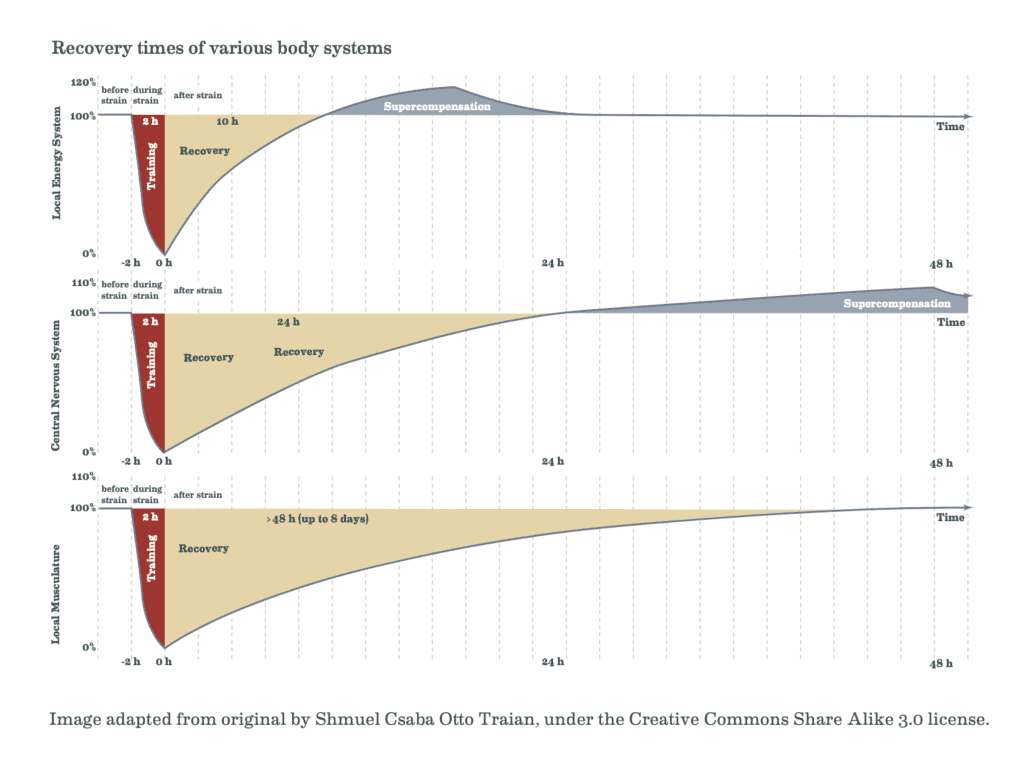
Riding the Wave
When training is executed properly, you apply enough stress (local and systemic) to elicit the desired adaptation response without flattening the readiness curve (always training, never improving) or adapting at the cost of another physiological system.
Over time, you want to stress the system enough to create a large specific adaptation response and then allow the body to recover. More is not necessarily better – you need enough stress to create an adaptation response, but not so much that you overwhelm the body or never back off and allow the body to adapt to the training response. How much volume you can handle in each physiological capacity (strength, energy systems, work capacity) depends on your fitness, but always falls within a predictable range. We’ve covered this in-depth in our book, and in articles on this site:
The graph below illustrates the process of stress accumulation, recovery and improved fitness over time when stress is managed effectively.
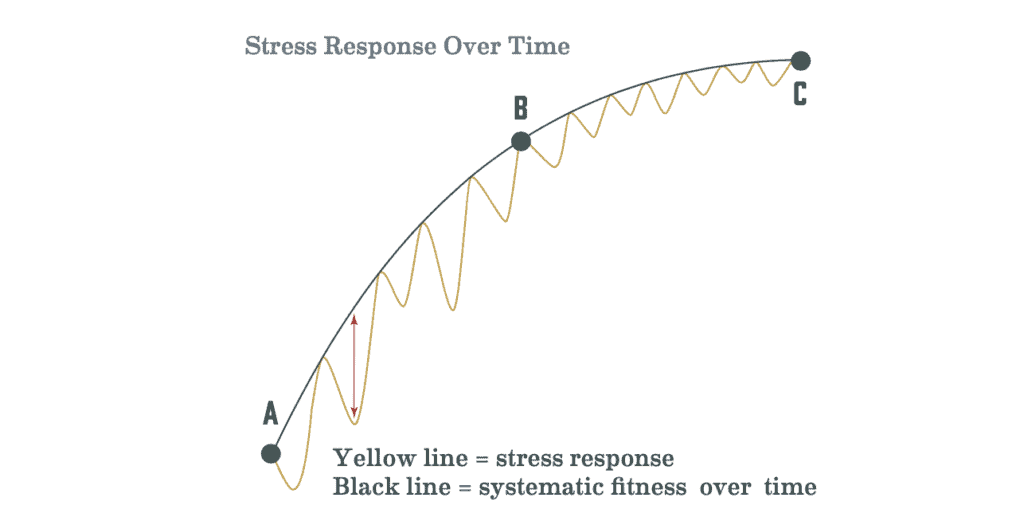
SUMMARY:
Your body’s response to training is both very specific and general in nature and the more variables that you can take into account the more effective your program will be. Understanding these principles will demystify the training process and help ensure that you make continual progress.
Thus, your goals are fairly simple for training yourself or someone else:
- Manage the training process so that the trainee receives adequate stress to cause adaptation, but not so much that they adapt at the cost of general health
- Monitor general and specific stress (more on this later) to avoid local injuries
- Improve performance in specific traits by applying the right stress at the right time
- Consider all stress including psychological and emotional stress, sleep, and nutrition to effectively manage the results of your client


